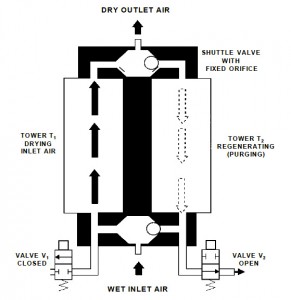Small-Flow Regenerative Desiccant Air Dryers for Ultra Dry Air
Most industrial users of compressed air are familiar with regenerative desiccant air dryers. These dryers are really the only choice when ultra-dry compressed air is required. Regenerative dryers provide line pressure dew points of -40°F and even -100°F. Standard dryers with capacities ranging from 50 SCFM to over 10,000 SCFM are common. Usually these dryers are installed within or very close to the location of the air compressors.
Not everyone is aware that regenerative desiccant dryers can also be used at or near the point-of-use. A typical point-of-use regenerative dryer has a flow capacity of 0.5 SCFM to 50 SCFM, such as the MHL series. These dryers deliver ultra-dry clean air in a wide range of applications. Here are some common examples:
|
|
Many facilities have small applications requiring very dry air, but the main compressed air system is either not dried, or treated with a refrigerated dryer which does not deliver a sufficiently low dew point. A small regenerative dryer upstream of a critical instrument or process is often the solution. This approach is cheaper than needlessly drying an entire air system to a -40° F dew point.
Small, fractional horsepower compressors can also be used in conjunction with these dryers, when other compressed air sources are not available. The small footprint of these dryers allows for installation in cramped areas. A standard power requirement is 115V. Optional 230V and 24VDC controls are also common. Power consumption is usually only a few watts to power the solid-state timer, which controls solenoid valves and the cycling of the desiccant chambers.
These small-flow dryers work essentially the same way as their larger counterparts. Desiccant regeneration is heatless pressure swing adsorption (PSA) with a purge air requirement of 15% to 25% of inlet flow. Although these dryers are small, and very simple, they are manufactured with industrial-grade components, making them very reliable, and requiring very little maintenance. With proper filtration, these dryers will typically operate several years without much attention at all. Here is a representation of the typical small-flow dryer:
As with any compressed air dryer, good filtration is essential to trouble-free operation. A high-efficiency coalescing prefilter is required upstream of the dryer, to prevent liquid oil or liquid water from contaminating the desiccant. To prevent any desiccant dust from migrating downstream of the dryer, a particulate afterfilter is required. A pressure regulator is also commonly installed at the outlet to regulate pressure downstream of the dryer. Typical set up is the same as with larger flow dryers:
For even smaller flow requirements, or where no power is available, non-regenerative, in-line cartridge type dryers, using silica gel or molecular sieve desiccant are available. These dryers also provide compressed air with a -40°F dew point. The desiccant in these dryers is not regenerated, but is replaced with a fresh cartridge when it becomes saturated.


